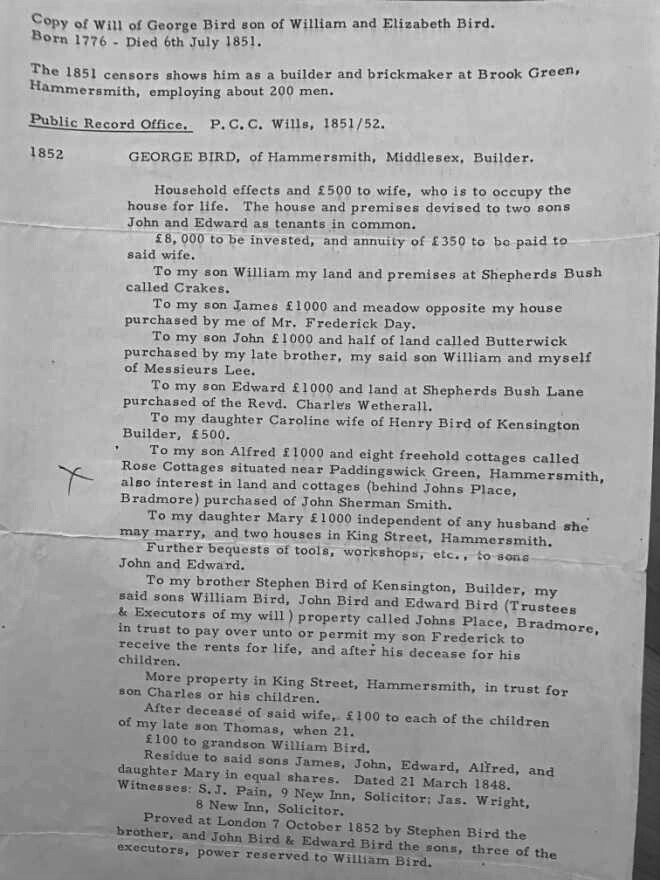Builders and brick makers in West London. Considering their contribution to many prominent projects (listed on the plaque), it is surprising that there is no information available on them.
We first published this in July 2011 but subsequently our colleague, Andrew Behan, has undertaken some research on the family. He could find no image of the Bird family, but instead we have used a transcription of which we think proves this to be the people concerned.
George Bird was born on 29 March 1774 in Ship Lane, Hammersmith, the third of the eight children of William Bird (1745-1788) and Elizabeth Bird née Knight (1744-1815). On 24 April 1774 he was baptised at the Church of Saint Mary, St Marylebone Road, St Marylebone, London.
His siblings were: Ann Sophia Bird (b.1766), Elizabeth Bird (b.1771), William Bird (1776-1884), Sarah Bird (1779-1836), Stephen Knight Bird (1780-1865), Thomas Bird (1783-1790) and Richard Henry Bird (1787-1787). After the death of his father in 1788, his widowed mother was remarried to a man called Stubbs and had three further children.
On 1 October 1803 he married Mary Wright (1785-1857) at St Botolph's Church, Aldgate, London, where the marriage register shows that they were both of this parish. In 1804 he was assessed to pay 15 shillings as Land Tax in the Hamlet of Hammersmith for property north of the Great Western Road. Also in that he year he was initiated as Freemason into the Caveac Lodge No.232 that met in the Angel Public House, King Street West, Hammersmith and he was recorded in their register as aged 30 years, a bricklayer, residing in Hammersmith.
He and his wife were to have ten children: William Bird (1805-1864), James Bird (1807-1868), Thomas Bird (1809-1847), Frederick Bird (1810-1871), Charles Bird (1813-1883), John Bird (1816-1881), Edward Bird (1817-1899), Caroline Bird (1820-1892), Alfred Bird (1821-1884) and Mary Bird (1825-1907).
On 19 October 1819 both he and his brother William Bird were admitted into the Freedom of the City of London by the redemption of £2-6s-8d each. They were both described as bricklayers residing in Hammersmith and on 25 January 1820 both were admitted into the Worshipful Company of Tylers and Bricklayers.
The 1838 electoral register lists him and his brother William as voters by means of being copyholders of a house and land in Brook Green, Hammersmith. His son, William was also eligible to vote by also residing in Brook Green but owning freehold land in Blythe Lane, Hammersmith. His son James, who lived in Sussex Place (now called Redan Street), Hammersmith was also registered to vote by owing copyhold tenements in Simpson's Place & Queen Street (now called Queen Caroline Street), Hammersmith.
In the 1841 census he is described as a builder living at Brook Green, Hammersmith, with his wife and two of their sons: Frederick, a coachmaker and Edward, a builder, together with two female servants. When the 1851 census was compiled he was shown as builder & brickmaker employing 200 men, still residing in Brook Green, Hammersmith, with his wife, their son John, who was also described as a builder, their daughter Mary, together with a cook and a housemaid.
He died, aged 77 years, on 6 July 1851 and was buried on 12 July 1851 in St Paul's Churchyard, Hammersmith.
Credit for this entry to: Alan Patient of www.plaquesoflondon.co.uk







Comments are provided by Facebook, please ensure you are signed in to see them